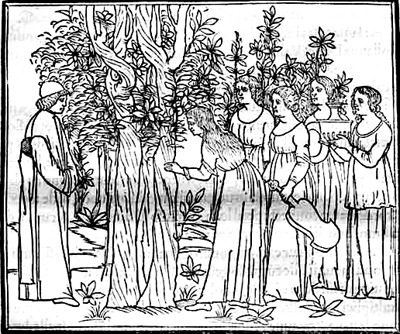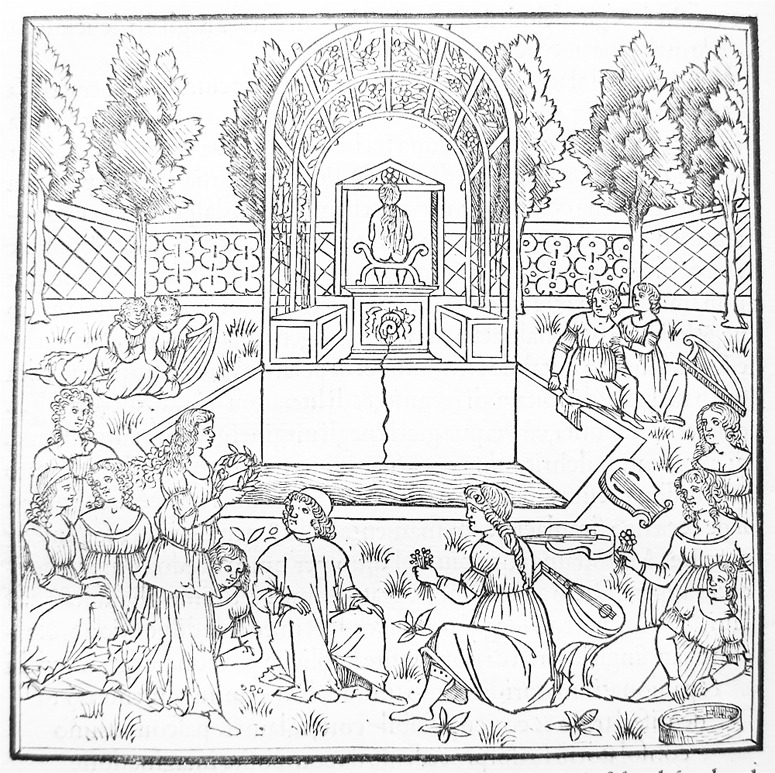An original copy of Hypnerotomachia Poliphili by Francesco Colonna (1499) is available on the web. It is a fabulous book and has been translated into English by Joscelyn Godwin. Colonna’s dreaming imagination embraces architecture, landscapes and gardens in a tale of passionate love – and eroticism.

'comely and beautiful maidens, taking their ease on the flowery grass and in the cool pleasant shade'
Polyphili meets a group of ‘friendly nymphs’ who invite him to join their bath – in a scene which might have inspired the much smuttier Hugh Hefner Playboy grotto: ‘Now that we had happily entered into such fragrance as could never have grown in Arabia, they spread out their silken garments neatly on the stone seats that served as dressing room… and unconcernedly let their shapely and delicious bodies be seen naked in every particular… I certainly could not prevent the ardent fires from leaping up to assault me in my furnace of a heart… but the nymphs, noticing it, found girlish amusement in laughing at my bashful demeanour’. Colonna was a Dominican monk but, as Godwin observes ‘we can surmise that Brother Francesco’s experience of women’s love was not limited to his dreams’.
The design dreams of the Hypnerotomachia are so rich that some scholars have attributed its authorship to Alberti. The word Hypnerotomachia is a compound of hypnos (sleep), eros (love) and mache (strife). Godwin, whom design historians must thank for his translation, renders this as The Strife of Love in a Dream and one wonders if the visions, both erotic and architectural, came to Colonna in a dream. I have not experienced such a combination but the best landscape design ideas I have had have all been when asleep. They have all been forgotten but Colonna may have put his dreams in words and images.
The graphic design of the Hypnerotomachia is admired as a masterwork from the printer, Aldus Pius Manutius (1450-1515), who devised the italic type and established the semicolon. This is the only illustrated book Aldus published and it is a brilliant example of the way in which words and images can be combined. I think garden design works best as a ‘word and image’ discipline (and regret that architecture seems to have lost much of this interest). Colonna had a far-reaching influence on gardens with his detailed descriptions of images, planting and construction ideas. He must be telling us something about the gardens he knew and he had a profound influence on the imagery used in renaissance, baroque and romantic gardens. Colonna influenced the Villa d’Este, Bomarzo, Versailles and Chiswick House. He also drew the earliest known image of what is called a knot garden in English. In Italian they were called compartmenti (compartments).


I have to admit that while the Hyperotomachia is fantastic I am still sceptical as to exactly how much it directly had an impact on garden design. I do know a lot of garden designers/architects owned copies though, but still I would love to see some more thorough study of it in relation to garden design over the centuries.
One good read on it that you might have seen but in case you haven’t is an issue of ‘Word and Image’ dedicated to the Hypnerotomachia, vol 14 issues 1&2, 1998.
Thank you for the reference. I shared your scepticism until I read Joscelyn Godwin’s Pagan Dream of the Renaissance (2005) and Emanuela Kretzulesco-Quaranta’s Les jardin du songe: Poliphile et la mystique de la renaissance (1986) – I think these may be the studies you are looking for. There is also a good short section in Godwin’s The real rule of four (2004) pp 136ff.
I have read Godwin’s book, will check out the other one, thanks (although my reading in French is a bit slow). I guess it isn’t that I don’t think it had an impact it is more that I so often see it invoked as a key source and I’m not so sure it was that central. It is hard to know exactly how widely read it was. Also in my study of the period there are other sources that discuss/show similar types of garden designs and similar concepts that I feel often get overlooked in favour of the Hypnerotomachia.
I agree – and I rather think Godwin would too. Paganism and related ideas were a broad and significant influence on art in general and and gardens in particular. So the Hyperotomachia becomes more a symptom than a cause, but it is also a convenient point of reference for the ideas.